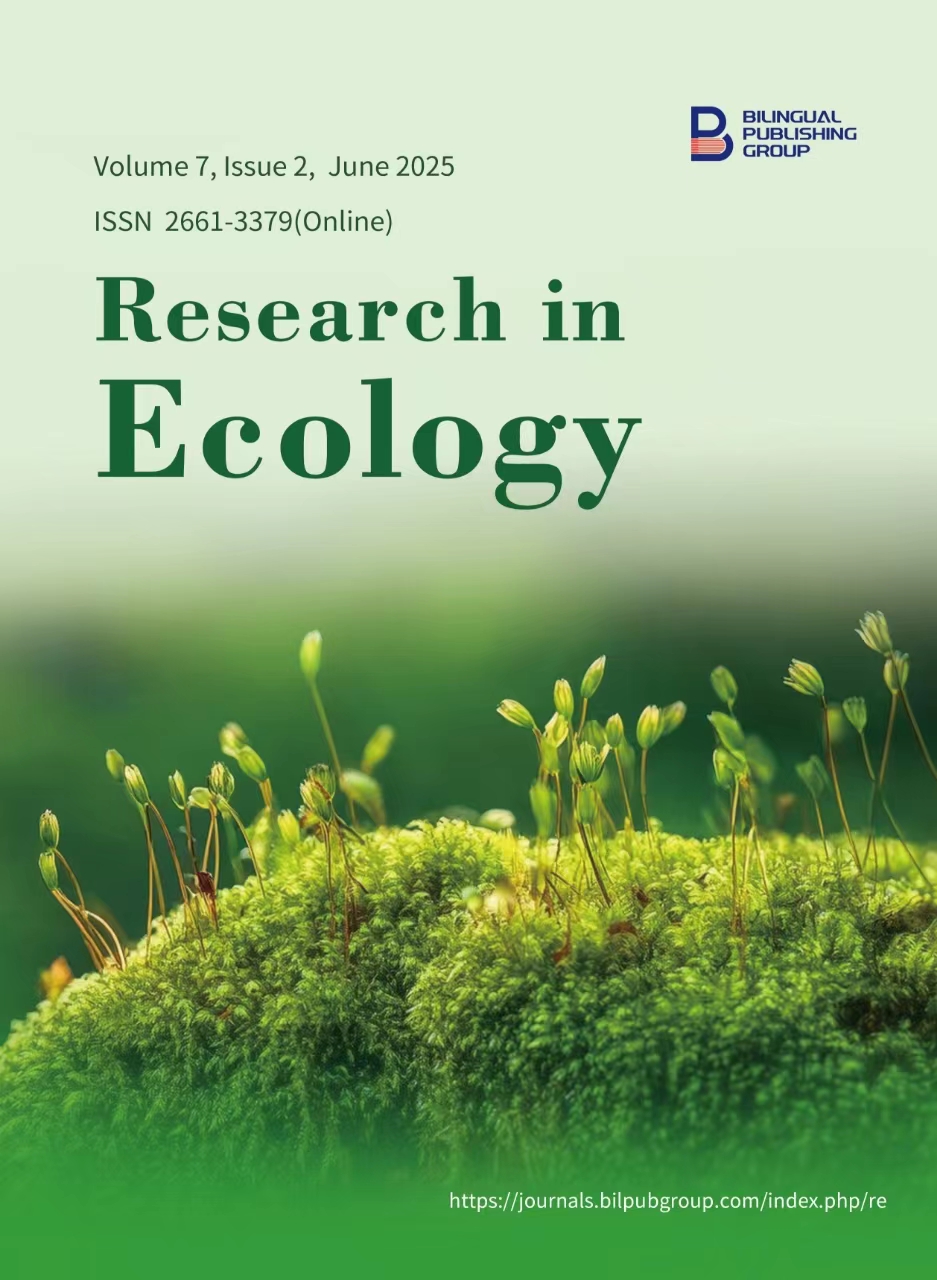
Sorption Activity of Plant Biosorbents in Wastewater Treatment
DOI:
https://doi.org/10.30564/re.v7i2.9048Abstract
Wastewater plays a crucial role in deteriorating water quality and can significantly affect human health and ecosystems if discharged without proper treatment. Among available treatment methods, adsorption is often considered an effective, relatively inexpensive, and environmentally friendly purification technique, but its efficiency depends on the sorbents used. The use of low-cost biosorbents with high adsorption capacity is widely studied. These include various biomaterials such as microalgae, cyanobacteria, fungi, and plant materials. The utilization of different biosorbents derived from plant waste, such as Paulownia wood, aspen, hickory, Ziziphus bark, peach tree shavings, as well as grasses such as red fescue and reed, and Sargassum algae in natural and modified forms, is a crucial research direction. Such studies highlight the potential to address waste issues by repurposing it as biosorbents. Several studies have examined the ability of different biosorbents to treat wastewater and suggested that the physicochemical properties of the material's surface, such as specific surface area, pore size, and pore volume, play a decisive role in adsorption capacity. A quantitative analysis of plant-based biosorbents will significantly aid in developing water treatment systems and achieving optimal adsorption through modifications of their physicochemical properties. Furthermore, the analysis will help understand the relative importance of each physicochemical property in determining adsorption capacity, thereby contributing to the implementation of treatment methods targeting specific pollutants.
Keywords: biosorption, plant sorbents, adsorption capacity, wastewater
References
[1] Holubiev, V., Simishko, V., 2021. Web Scraping and Text Mining of Ukrainian News Articles About Ecology. Proceedings of the 2021 11th International Conference on Advanced Computer Information Technologies (ACIT); 15–17 September 2021; Deggendorf, Germany. pp. 672–675. DOI: https://doi.org/10.1109/ACIT52158.2021.9548450
[2] Grinberga-Zalite, G., Zvirbule, A., 2022. Analysis of Waste Minimization Challenges to European Food Production Enterprises. Emerging Science Journal. 6(3), 530–543. DOI: https://doi.org/10.28991/ESJ-2022-06-03-08
[3] Novikova, I.V., Muravev, A.S., Agafonov, G.V., et al., 2022. Technological measures to improve the environmental friendliness of alcohol industry enterprises. Proceedings of the Processing of Agricultural Raw Materials (P2ARM 2021); 21–24 September 2021; Voronezh, Russia. IOP Conference Series: Earth and Environmental Science. 1052(1), 012092. DOI: https://doi.org/10.1088/1755-1315/1052/1/012092
[4] Zielińska, M., Bułkowska, K., Mikucka, W., 2021. Valorization of distillery stillage for bioenergy production: A review. Energies. 14(21), 7235. DOI: https://doi.org/10.3390/en14217235
[5] Semenova, O., Suleyko, T., Siryk, A., et al., 2022. Environmental and security aspects wastewater treatment stations of food industry in Ukraine. Journal of Hygienic Engineering and Design. 38, 40–45.
[6] Nikolaienko, M., Bal-Prylypko, L., 2020. Development of an integrated food quality management system. Potravinarstvo Slovak Journal of Food Sciences. 14, 862–873. DOI: https://doi.org/10.5219/1434
[7] Frankenberger, W.T., Amrhein, C., Fan, T.W.M., et al., 2004. Advanced treatment technologies in the remediation of seleniferous drainage waters and sediments. Irrigation Drainage Systems. 18, 19–42.
[8] Oman, J., Dejanovic, B., Tuma, M., 2002. Solutions to the problem of waste deposition at a coal-fired power plant. Waste Management. 22, 617–623.
[9] Mohana, S., Acharya, B.K., Madamwar, D., 2009. Distillery spent wash: treatment technologies and potential applications. Journal of Hazardous Materials. 163(1), 12–25. DOI: https://doi.org/10.1016/j.jhazmat.2008.06.079
[10] Holub, G.A., Dubrovina, O.V., 2013. Kinetics of anaerobic fermentation of plant biomass. Scientific Bulletin of the National University of Bioresources and Nature Management of Ukraine. Series: Technique and energy of the agro-industrial complex. 185(2), 296–301.
[11] Danilova, K., Oliynichuk, S., Verbytskyi, S., 2023. Bioutilization of the distillery stillage of different grain species from bioethanol production. Ecological Questions. 34(4), 1–12. DOI: https://doi.org/10.12775/EQ.2023.050
[12] Mehta, S.K., Gaur, J.P., 2005. Use of algae for removing heavy metal ions from wastewater: Progress and prospects. Critical Reviews in Biotechnology. 25, 113–152.
[13] Volesky, B., 2007. Biosorption and me. Water Research. 41(18), 4017–4029.
[14] Gadd, G.M., 2009. Biosorption: Critical review of scientific rationale, environmental importance and significance for pollution treatment. Journal of Chemical Technology & Biotechnology. 84(1), 13–28.
[15] Rashmi, N., Salmataj, S., Senthil Kumar, P., et al., 2024. Exploring chemically and physically modified plant-based fiber biomass for biosorption in wastewater treatment: A concise review. Journal of Water Process Engineering. 67, 106245. DOI: https://doi.org/10.1016/j.jwpe.2024.106245
[16] Srivastava, C.S., Singh, S.J., Srivastava, P.S., et al., 2022. A review on biosorbents. International Journal of Research and Analytical Reviews. 9(1), 370–382.
[17] Coelho, G.F., Gonçalves, A.G., Tarley, C.R.T., et al., 2014. Removal of metal ions Cd (II), Pb (II), and Cr (III) from water by the cashew nut shell Anacardium occidentale L. Journal of Ecological Engineering. 73, 514–525. DOI: https://doi.org/10.1016/j.ecoleng.2014.09.103
[18] Rambabu, K., Bharath, G., Banat, F., et al., 2020. Biosorption performance of date palm empty fruit bunch wastes for toxic hexavalent chromium removal. Environmental Research. 187, 109694. DOI: https://doi.org/10.1016/j.envres.2020.109694
[19] Kamsonlian, S., Suresh, S., Majumder, C.B., et al., 2011. Characterization of banana and orange peels: biosorption mechanism. International Journal of Science, Technology & Management. 2(4), 1–7.
[20] Mehtab, H., Asmaas, A., Tehmina, K., et al., 2025. Efficient removal of manganese (II) ions from aqueous solution using biosorbent derived from rice husk. Sustainable Chemistry One World. 5, 100047. DOI: https://doi.org/10.1016/j.scowo.2025.100047
[21] Ebrahimi, R., Maleki, A., Shahmoradi, B., et al., 2013. Elimination of arsenic contamination from water using chemically modified wheat straw. Desalination and Water Treatment. 51(10-12), 2306–2316. DOI: https://doi.org/10.1080/19443994.2012.734675
[22] Bozic, D., Gorgievski, M., Stankovic, V., et al., 2021. Biosorption of lead ions from aqueous solutions by beech sawdust and wheat straw. Chemical Industry & Chemical Engineering Quarterly. 27(1), 21–34. DOI: https://doi.org/10.2298/CICEQ191113021B
[23] Jalali, A., Mirnezami, F., Lotfi, M., et al., 2021. Biosorption of lead ion from aqueous environment using wheat stem biomass. Desalination and Water Treatment. 233, 98–105. DOI: https://doi.org/10.5004/dwt.2021.27518
[24] Weng, C.H., Lin, Y.T., Hong, D.Y., et al., 2014. Effective removal of copper ions from aqueous solution using base treated black tea waste. Journal of Ecological Engineering. 67, 127–133. DOI: https://doi.org/10.1016/j.ecoleng.2014.03.053
[25] Tariq, A., Farhat, F., 2025. Insights into microbe assisted remediation in plants: a brief account on mechanisms and multi-omic strategies against heavy metal toxicity. Stress Biology. 5(1), 4. DOI: https://doi.org/10.1007/s44154-024-00168-8
[26] Domozych, D.S., Ciancia, M., Fangel, J.U., et al., 2012. The cell walls of green algae: a journey through evolution and diversity. Frontiers in Plant Science. 3, 82.
[27] Davis, T.A., Volesky, B., Mucci, A., 2003. A review of heavy metal biosorption by brown algae. Water Research. 37(18), 4311–4330.
[28] Latva, S., Peraniemi, S., Ahlgren, M., 2003. Study of metal-loaded activated charcoals for the separation and determination of selenium species by energy dispersive X-ray fluorescence analysis. Analytica Chimica Acta. 478(2), 229–235.
[29] Bird, M.I., Wurster, C.M., Silva, P.H.D., et al., 2011. Algal biochar–production and properties. Bioresource Technology. 102(2), 1886–1891.
[30] Roberts, D.A., Paul, N.A., de Nys, R. (inventors), 2013. Biosorbents and methods of use. Provisional patent. 27326. 2014 March 21.
[31] Lalvani, S.B., 2004. Selenium removal from agricultural drainage water: Lab scale studies. Department of Water Resources: Sacramento, CA, USA. pp. 86.
[32] Yang, T., Chen, M.-L., Liu, L.-H., et al., 2012. Iron(III) Modification of Bacillus subtilis membranes provides record sorption capacity for arsenic and endows unusual selectivity for As(V). Environmental Science & Technology. 46(4), 2251–2256.
[33] Damacena, D.H.L., Trigueiro, P., Monteiro, V.H., et al., 2023. Saponite-inspired Materials as Remediation Technologies for Water Treatment: an Overview. Environmental Processes. 10(1), 15.
[34] Bal-Prylypko, L.V., Palamarchuk, I.P., Nikolaienko, M.S., 2019. Mathematical modeling of the wastewater treatment system of meat processing enterprises with projected measures of process intensification. Agricultural food industry. 3–4, 6–11.
[35] ISO 7027-1:2016. 2016. Water quality — Determination of turbidity. Part 1: Quantitative methods.
[36] Lade, B., Patil, A.S., Paikrao, H., et al., 2014. A Comprehensive Working, Principles and Applications of Thin Layer Chromatography. Research Journal of Pharmaceutical Biological and Chemical Sciences. 5(4), 486–503.
[37] APHA, 2005. Standard Methods for the Examination of Water and Wastewater, 21st ed. American Public Health Association: Washington, DC, USA.
[38] ISO 6060:1989. 1989. Water quality - Determination of the chemical oxygen demand.
[39] Delzer, G.C., McKenzie, S.W., 2003. Chapter A7. Five-Day Biochemical Oxygen Demand: U.S. Geological Survey Techniques of Water-Resources Investigations, book 9, chap A7.0. U.S. Geological Survey: Reston, VA, USA. DOI: https://doi.org/10.3133/twri09A7.0
[40] ISO/TC 34/SC 4: ISO 20483:2013. 2013. Cereals and pulses - Determination of the nitrogen content and calculation of the crude protein content - Kjeldahl method.
[41] ISO 6878:2004. 2004. Water quality — Determination of phosphorus — Ammonium molybdate spectrometric method
[42] Harris, D.C., 2010. Quantitative Chemical Analysis. Freeman: New York, USA.
[43] Siedlecka, E., Kumirska, J., Ossowski, T., Glamowski, P., Gołebiowski, M., Gajdus, J., Kaczyński, Z., Stepnowski, P., 2008. Determination of volatile fatty acids in environmental aqueous samples. Polish Journal of Environmental Studies. 17(3), 351-356.
[44] Reddy, P.D.P., Reddy, V.C.V., Gowri, T., 2017. Whale optimization algorithm for optimal sizing of renewable resources for loss reduction in distribution systems. Manohar Renewables. 4(3). DOI: https://doi.org/10.1186/s40807-017-0040-1
[45] Shahadat, M., Isamil, S., 2018. Regeneration performance of clay-based adsorbents for the removal of industrial dyes: a review. RSC Advances. 8, 24571–24587. DOI: https://doi.org/10.1039/C8RA04290J
[46] Osman, A.I., Abd El-Monaem, E.M., Elgarahy, A.M., et al., 2023. Methods to prepare biosorbents and magnetic sorbents for water treatment: a review. Environmental Chemistry Letters. 21(4), 2337–2398. DOI: https://doi.org/10.1007/s10311-023-01603-4
[47] Liu, X., Shen, F., Smith, R.L.J., et al., 2019. Black liquor-derived calcium-activated biochar for recovery of phosphate from aqueous solutions. Bioresource Technology. 294, 122198. DOI: https://doi.org/10.1016/j.biortech.2019.122198
[48] Baskar, V., Bolan, N., Hoang, S.A., et al., 2022. Recovery, regeneration and sustainable management of spent adsorbents from wastewater treatment streams: A review. Science of The Total Environment. 822, 153555. DOI: https://doi.org/10.1016/j.scitotenv.2022.153555
Downloads
How to Cite
Issue
Article Type
License
Copyright © 2025 Anna Poshtarenko, Kateryna Danilova, Lyudmila Reshetnyak, Inga Kuznetsova, Larysa Bal-Prylypko, Ihor Ustymenko, Rodion Rybchynskyi, Maksym Ryabovol, Bohdana Leonova, Halyna Tolok, Lyudmila Bejko

This is an open access article under the Creative Commons Attribution-NonCommercial 4.0 International (CC BY-NC 4.0) License.




 Anna Poshtarenko
Anna Poshtarenko






